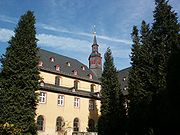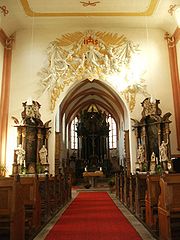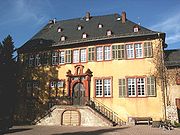.gif)
Schönau Abbey (Nassau)
Encyclopedia



Limburg an der Lahn
Limburg an der Lahn is the district seat of Limburg-Weilburg in Hesse, Germany.-Location:Limburg lies in western Hesse between the Taunus and the Westerwald on the river Lahn....
on the outskirts of the municipality of Strüth
Strüth
Strüth is a municipality in the district of Rhein-Lahn, in Rhineland-Palatinate, in western Germany....
in the Rhein-Lahn district, Rhineland-Palatinate
Rhineland-Palatinate
Rhineland-Palatinate is one of the 16 states of the Federal Republic of Germany. It has an area of and about four million inhabitants. The capital is Mainz. English speakers also commonly refer to the state by its German name, Rheinland-Pfalz ....
, Germany
Germany
Germany , officially the Federal Republic of Germany , is a federal parliamentary republic in Europe. The country consists of 16 states while the capital and largest city is Berlin. Germany covers an area of 357,021 km2 and has a largely temperate seasonal climate...
. It is often referred to as Schönau Abbey of Nassau
Nassau (state)
Nassau was a German state within the Holy Roman Empire and later in the German Confederation. Its ruling dynasty, now extinct in male line, was the House of Nassau.-Origins:...
(because it was founded by the House of Nassau
House of Nassau
The House of Nassau is a diversified aristocratic dynasty in Europe. It is named after the lordship associated with Nassau Castle, located in present-day Nassau, Rhineland-Palatinate, Germany. The lords of Nassau were originally titled Count of Nassau, then elevated to the princely class as...
and was located in their lands) or Schönau Abbey im Taunus
Taunus
The Taunus is a low mountain range in Hesse, Germany that composes part of the Rhenish Slate Mountains. It is bounded by the river valleys of Rhine, Main and Lahn. On the opposite side of the Rhine, the mountains are continued by the Hunsrück...
, in order to differentiate it from the other Schönau Abbey
Schönau Abbey
Schönau Abbey in Schönau in the Odenwald, in the Rhein-Neckar-Kreis in Baden-Württemberg, was a Cistercian monastery founded in 1142 from Eberbach Abbey...
in Baden-Württemberg
Baden-Württemberg
Baden-Württemberg is one of the 16 states of Germany. Baden-Württemberg is in the southwestern part of the country to the east of the Upper Rhine, and is the third largest in both area and population of Germany's sixteen states, with an area of and 10.7 million inhabitants...
. This Schönau Abbey is most well known as the convent
Convent
A convent is either a community of priests, religious brothers, religious sisters, or nuns, or the building used by the community, particularly in the Roman Catholic Church and in the Anglican Communion...
of St. Elizabeth of Schönau
Elizabeth of Schönau
Elizabeth of Schönau was a German Benedictine visionary. When her writings were published, the title of "Saint" was added to her name. She was never canonized, but in 1584 her name was entered in the Roman Martyrology and has remained there...
.
History
Schönau Abbey was founded in 1126 as a BenedictineBenedictine
Benedictine refers to the spirituality and consecrated life in accordance with the Rule of St Benedict, written by Benedict of Nursia in the sixth century for the cenobitic communities he founded in central Italy. The most notable of these is Monte Cassino, the first monastery founded by Benedict...
abbey by Count Robert I of Nassau
Robert I of Nassau
Robert I of Nassau was from 1123 co-Count of Laurenburg and would later title himself the first Count of Nassau. The House of Nassau would become an important aristocratic family in Germany, from which are descended the present-day rulers of both the Netherlands and Luxembourg.-Biography:Robert...
, the Vogt
Vogt
A Vogt ; plural Vögte; Dutch voogd; Danish foged; ; ultimately from Latin [ad]vocatus) in the Holy Roman Empire was the German title of a reeve or advocate, an overlord exerting guardianship or military protection as well as secular justice...
of Lipporn
Lipporn
Lipporn is a municipality in the district of Rhein-Lahn, in Rhineland-Palatinate, in western Germany....
. The property on which the monastery was built had already been donated in 1117 by Count Dudo-Henry of Laurenburg
Dudo-Henry of Laurenburg
Dudo-Henry of Laurenburg was Count of Laurenburg in 1093 and is considered the founder of the House of Nassau...
, Robert’s father and predecessor, to Schaffhausen Abbey for establishment of the monastery. Its Romanesque buildings were constructed between 1126 and 1145, presumably with a three-nave basilica
Basilica
The Latin word basilica , was originally used to describe a Roman public building, usually located in the forum of a Roman town. Public basilicas began to appear in Hellenistic cities in the 2nd century BC.The term was also applied to buildings used for religious purposes...
.
At the same time, a nuns convent
Convent
A convent is either a community of priests, religious brothers, religious sisters, or nuns, or the building used by the community, particularly in the Roman Catholic Church and in the Anglican Communion...
was founded next to the monk's monastery. St. Elizabeth of Schönau
Elizabeth of Schönau
Elizabeth of Schönau was a German Benedictine visionary. When her writings were published, the title of "Saint" was added to her name. She was never canonized, but in 1584 her name was entered in the Roman Martyrology and has remained there...
worked there from 1141 until her death in 1164. Her brother Eckbert of Schönau
Egbert
Several Anglo-Saxon persons were named Ecgberht . The name itself means "Bright Edge," such as that of a blade.*Ecgberht of Kent *Saint Egbert , hermit and missionary...
(died 1184) entered the men’s monstery at Schönau in 1155 or 1156.
Schönau Abbey had grown strong enough economically by 1340 that the city of Frankfurt am Main could promise support through arms and wagons. A Gothic
Gothic architecture
Gothic architecture is a style of architecture that flourished during the high and late medieval period. It evolved from Romanesque architecture and was succeeded by Renaissance architecture....
chancel
Chancel
In church architecture, the chancel is the space around the altar in the sanctuary at the liturgical east end of a traditional Christian church building...
(still extant today) and a chapel dedicated to St. Elizabeth were added between 1420 and 1430 on the north side of the nave.
During the Protestant Reformation
Protestant Reformation
The Protestant Reformation was a 16th-century split within Western Christianity initiated by Martin Luther, John Calvin and other early Protestants. The efforts of the self-described "reformers", who objected to the doctrines, rituals and ecclesiastical structure of the Roman Catholic Church, led...
, the surrounding communities of Strüth
Strüth
Strüth is a municipality in the district of Rhein-Lahn, in Rhineland-Palatinate, in western Germany....
, Welterod
Welterod
Welterod is a municipality in the district of Rhein-Lahn, in Rhineland-Palatinate, in western Germany....
, and Lipporn
Lipporn
Lipporn is a municipality in the district of Rhein-Lahn, in Rhineland-Palatinate, in western Germany....
became Protestant between 1541 and 1544, but Schönau Abbey remained Catholic. In 1606 the convent was dissolved because only a few sisters still lived in Schönau under fairly loose religious rule.
During the Thirty Years War, Swedish
Sweden
Sweden , officially the Kingdom of Sweden , is a Nordic country on the Scandinavian Peninsula in Northern Europe. Sweden borders with Norway and Finland and is connected to Denmark by a bridge-tunnel across the Öresund....
and Hessian
Hesse
Hesse or Hessia is both a cultural region of Germany and the name of an individual German state.* The cultural region of Hesse includes both the State of Hesse and the area known as Rhenish Hesse in the neighbouring Rhineland-Palatinate state...
soldiers attacked Schönau Abbey between 1631 and 1635. The Swedes drove off the monks, plundered the monastery, broke into the grave of St. Elizabeth and scattered her bones. Only the skull was rescued. It is now preserved in a reliquary
Reliquary
A reliquary is a container for relics. These may be the physical remains of saints, such as bones, pieces of clothing, or some object associated with saints or other religious figures...
on the right-side altar of the church.
A major fire in 1723 destroyed the church and convent, and only the Gothic chancel remains extant today from the original buildings. The abbey received its present shape in reconstruction over the following years. The chapel to Elizabeth, however, was not rebuilt.
Recent history
In the course of secularizationGerman Mediatisation
The German Mediatisation was the series of mediatisations and secularisations that occurred in Germany between 1795 and 1814, during the latter part of the era of the French Revolution and then the Napoleonic Era....
in 1802 and 1803, the monk’s community was dissolved and the monastery became the property of the state of Nassau
Nassau (state)
Nassau was a German state within the Holy Roman Empire and later in the German Confederation. Its ruling dynasty, now extinct in male line, was the House of Nassau.-Origins:...
. Some of the buildings were sold to private individuals. The parish previously affiliated with Schönau Abbey became part of the Vicariate General
Vicar general
A vicar general is the principal deputy of the bishop of a diocese for the exercise of administrative authority. As vicar of the bishop, the vicar general exercises the bishop's ordinary executive power over the entire diocese and, thus, is the highest official in a diocese or other particular...
of Limburg an der Lahn
Limburg an der Lahn
Limburg an der Lahn is the district seat of Limburg-Weilburg in Hesse, Germany.-Location:Limburg lies in western Hesse between the Taunus and the Westerwald on the river Lahn....
, which would then become the Diocese of Limburg in 1827.
In 1904, the Dernbacher Sisters (officially, the Ancillae Domini Jesu Christi, the Poor Handmaids of Jesus Christ
Poor Handmaids of Jesus Christ
The Poor Handmaids of Jesus Christ is a religious order of Catholic women. The Poor Handmaids of Jesus Christ American Province has its motherhouse in Donaldson, Indiana.-Ministries:...
) moved into the monastery. From 1947 to 1975, displaced Premonstratensian
Premonstratensian
The Order of Canons Regular of Prémontré, also known as the Premonstratensians, the Norbertines, or in Britain and Ireland as the White Canons , are a Catholic religious order of canons regular founded at Prémontré near Laon in 1120 by Saint Norbert, who later became Archbishop of Magdeburg...
s from Teplá Abbey
Teplá Abbey
Teplá Abbey is a Premonstratensian abbey in the western part of Bohemia, included in the Archdiocese of Prague; it was founded in 1193 by the blessed Hroznata, a Bohemian nobleman...
in Czechoslovakia
Czechoslovakia
Czechoslovakia or Czecho-Slovakia was a sovereign state in Central Europe which existed from October 1918, when it declared its independence from the Austro-Hungarian Empire, until 1992...
also lived there. The last Dernbacher sisters left the monastery in 1986.
Since then the buildings have been used by the local Catholic parish of St. Florin. In 1994, the parish established the Schönauer Book Corner as a public library. Three years later, the former work buildings became "One World House, Schönau Abbey" a learning and meeting place for groups. Also in the rooms of the One World House, a computer training facility and an Internet café were opened in 2001.
External links
This article incorporates text translated from the corresponding German Wikipedia article, as of 2009-01-25.

